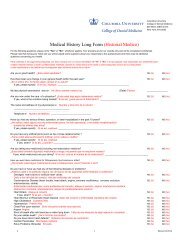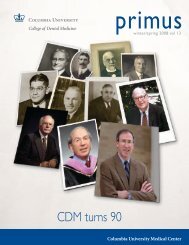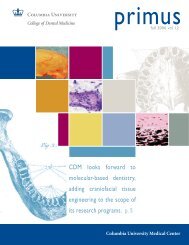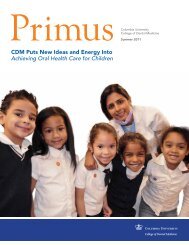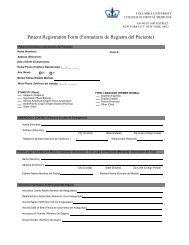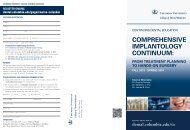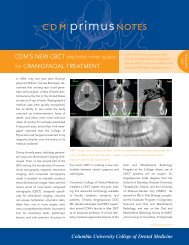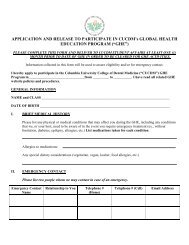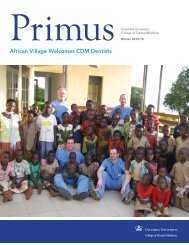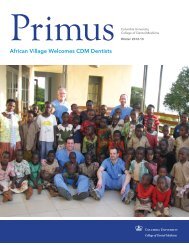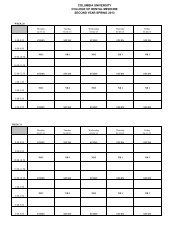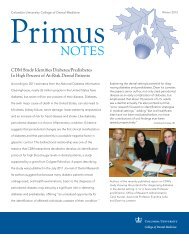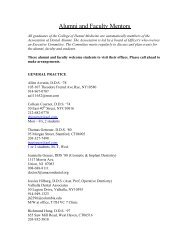Jarvie Journal - College of Dental Medicine - Columbia University
Jarvie Journal - College of Dental Medicine - Columbia University
Jarvie Journal - College of Dental Medicine - Columbia University
Create successful ePaper yourself
Turn your PDF publications into a flip-book with our unique Google optimized e-Paper software.
Volume 56, Spring 2013<br />
Maxillary Sinus Augmentation and Vitamin D Insufficiency- a Systemic-<br />
Local Connection<br />
Wang, K 1 , Wu, C 2 , Dietrich, T 3 , Dibart, S 4 , Schulze-Späte, U 1 *<br />
1 Division <strong>of</strong> Periodontics, <strong>College</strong> <strong>of</strong> <strong>Dental</strong> <strong>Medicine</strong>, <strong>Columbia</strong> <strong>University</strong>;<br />
2 Division <strong>of</strong> Cardiology, Department <strong>of</strong> <strong>Medicine</strong>, <strong>Columbia</strong> <strong>University</strong>;<br />
3 <strong>University</strong> <strong>of</strong> Birmingham; 4 Department <strong>of</strong> Periodontology, Boston <strong>University</strong>, MA *Faculty Mentor<br />
Introduction: Implant placement in the edentulous maxilla <strong>of</strong>ten represents a clinical challenge due to<br />
insufficient bone height after crestal bone resorption and maxillary sinus pneumatization. Tatum et al<br />
was the first one describing a procedure, which utilizes existing space in the maxillary sinus by lifting up<br />
the Schneiderian membrane from its bony surface and filling this newly created space with augmentation<br />
material. Several grafting materials can be used to augment bone height in the posterior maxilla:<br />
autogenous bone, allografts (harvested from human cadavers), alloplasts (synthetic materials), and<br />
xenografts (grafts from nonhuman species). After graft placement, particles will partially be remodeled<br />
and replaced by the patient`s own bone. This process is a complex mechanism and influenced by several<br />
factors associated with overall bone metabolism.<br />
Vitamin D plays an essential role in calcium homeostasis and is essential for bone formation and<br />
remodeling. It promotes coupling <strong>of</strong> bone resorption to bone formation on a cellular level and, therefore,<br />
optimizes bone remodeling. Whether low vitamin D serum levels are associated with less bone<br />
remodeling after maxillary sinus augmentation has not been evaluated.<br />
Objective: This pilot cohort study will investigate bone formation and remodeling after sinus<br />
augmentation and determine Vitamin D levels throughout the treatment.<br />
Materials & Methods: Patients (age: 48.6±12.6, 28.2±5.1) underwent sinus augmentation surgery using<br />
β-tri-calcium phosphate as a grafting material (n=20). 24 weeks after sinus augmentation, implants were<br />
placed and a bone core was harvested from the same site. The bone core was analyzed histologically and<br />
histomorphometrically to evaluate bone regeneration and remodeling within the sinus graft. Blood<br />
samples were collected at the baseline visit and after 2, 12 and 24 weeks to determine serum levels <strong>of</strong><br />
calcium and 25-hydroxyvitamin D (25-OHD). The association between 25-OHD serum levels and bone<br />
regeneration in the grafted sinus was analyzed.<br />
Results & Conclusions: Patients with deficient Vitamin D levels (25 (OH) D: 30ng/ml)<br />
(41.13±4 vs. 48.8±3.6 % <strong>of</strong> total area), whereas the amount <strong>of</strong> remaining graft material was higher in<br />
Vitamin D insufficient patients (16.1±6 vs. 13.9±2.6 % <strong>of</strong> total area). In line with these findings, more<br />
osteoclasts were detected around bone and graft particles in bone cores taken from the Vitamin D<br />
sufficient patient group (1.7±0.5 vs 2.6±0.7 (bone), 1.89±0.75 vs 2.71±1.05 (graft).<br />
Discussion: Our findings suggest that sufficient Vitamin D serum levels might be advantageous for bone<br />
remodelling after maxillary sinus augmentation. Bone biopsies taken from patients with insufficient<br />
Vitamin D levels were less metabolically active and had less bone and more remaining graft material.<br />
Several studies have demonstrated that vitamin D supplementation increases bone mineral density.<br />
Therefore, future studies could evaluate whether Vitamin D supplementation might improve bone<br />
formation after sinus grafting.<br />
Kun Wang was supported by a <strong>College</strong> <strong>of</strong> <strong>Dental</strong> <strong>Medicine</strong> Pre-Doctoral Summer Research Fellowship.<br />
29



